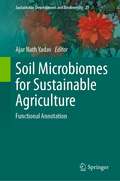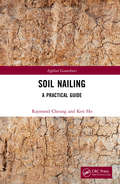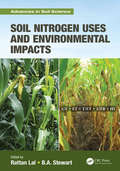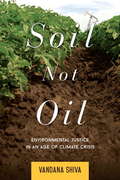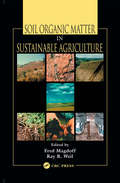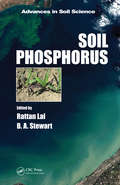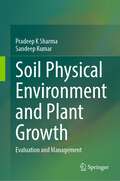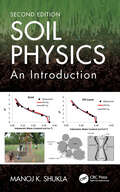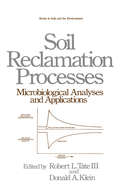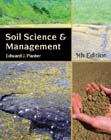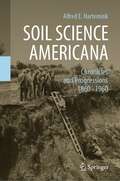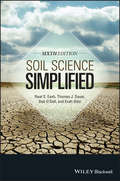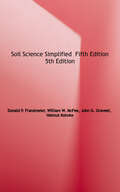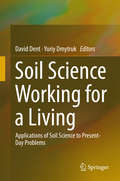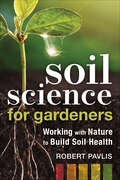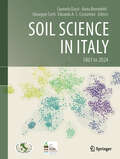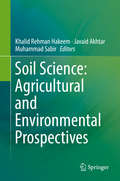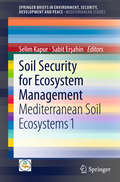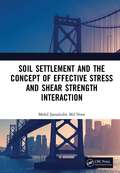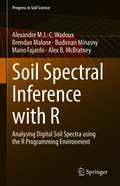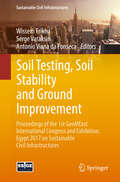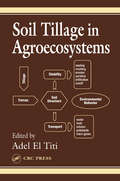- Table View
- List View
Soil Microbiomes for Sustainable Agriculture: Functional Annotation (Sustainable Development and Biodiversity #27)
by Ajar Nath YadavThis book encompasses current knowledge of soil microbiomes and their potential biotechnological application for plant growth, crop yield, and soil health under the natural as well as harsh environmental conditions for sustainable agriculture. The microbes are ubiquitous in nature. The soil is a natural hotspot of the soil microbiome. The soil microbiome plays a critical role in the maintenance of global nutrient balance and ecosystem functioning. The soil microbiomes are associated with plant ecosystems through the intense network of plant–microbe interactions. The microbes present in bulk soil move toward the rhizospheric region due to the release of different nutrients by plant systems. The rhizospheric microbes may survive or proliferate in rhizospheric zone depending on the extent of influences of the chemicals secreted into the soil by roots. The root exudates contain the principal nutrients factors (amino acids, glucose, fructose, and sucrose). The microbes present in rhizospheric region have capabilities to fix atmospheric nitrogen, produce different phytohormones, and solubilize phosphorus, potassium, and zinc. The plant systems take these nutrients for their growth and developments. These soil and plant associated microbes also play an important role in protection of plants from different plant pathogenic organisms by producing different secondary metabolites such as ammonia, hydrogen cyanide, siderophores, and hydrolytic enzymes. The soil microbiomes with plant growth-promoting (PGP) attributes have emerged as an important and promising tool for sustainable agriculture. The soil microbiomes promote the plant growth and enhance the crop yield and soil fertility via directly or indirectly different plant growth-promoting mechanism. The soil microbes help the plant for adaptation in extreme habitats by mitigating the abiotic stress of high/low temperatures, hypersalinity, drought, and acidic/alkaline soil. These PGP microbes are used as biofertilizers/bioinoculants to replace the harmful chemical fertilizers for sustainable agriculture and environments.The aim of the book “Soil Microbiomes for Sustainable Agriculture” is to provide the recent advances in mechanisms of plant growth promotion and applications of soil microbiomes for mitigation of different abiotic stresses in plants. The book is useful to scientists, researchers, and students related to microbiology, biotechnology, agriculture, molecular biology, environmental biology, and related subjects.
Soil Nailing: A Practical Guide
by Ken Ho Raymond CheungSoil nailing is an in situ soil reinforcement technique that can be used to enhance the stability of slopes, retaining walls, embankments, and excavations. It involves installation of closely spaced, relatively slender unstressed tension-carrying structural elements into the ground to stabilize the soil mass. These elements, which are called soil nails, comprise steel or other engineering materials such as fiber reinforced polymer. Soil nailing did not gain popularity until the 1970s when engineers started to realize that the technique could offer an effective, robust, and economical reinforcing system for a variety of ground conditions. More importantly, the track record has been excellent in that no major collapses have been reported in properly designed and well-constructed soil nailed structures so far. Considerable experience and knowledge of the technique have been gained in the past few decades through systematic technical development work comprising laboratory tests, numerical modeling, physical modeling, site trials and field monitoring covering design, and construction practices. Soil Nailing: A Practical Guide consolidates the experience and advances made in the development and use of the soil nailing technique and encourages a wider adoption of the technique by practitioners. The book is intended for use by postgraduate students, researchers, and practicing civil and geotechnical engineers, who wish to have a more in-depth and fundamental understanding of the theory and practice behind the technique. It presents the basic principles of the technique as well as state-of-the-art knowledge and recommended standard of good practice in respect of design, construction, monitoring, and maintenance of soil nailed structures.
Soil Nitrogen Uses and Environmental Impacts (Advances in Soil Science)
by Rattan Lal B. A. StewartNitrogen (N) is potentially one of the most complex elements on the Earth. It is necessary for all biological activity, but creates negative impacts on water and air quality. There is a balancing act between deficiency and surplus and the forms of N available further complicate our understanding of the dynamics. Biological fixation provides some plants with N supply while others are totally dependent upon N being available in the soil profile for the roots to extract. Nevertheless, the demand for N will increase because the human population with its increasing growth requires more protein and thus more N. Understanding the global N cycle is imperative to meeting current and future nitrogen demands while decreasing environmental impacts. This book discusses availability, production, and recycling of N in air, water, plants, and soils. It features information on N impacts to soil and water quality, management of N in agroecosystems, and techniques to maximize the use efficiency while minimizing the risks of leakage of reactive N into the environment. This volume in the Advances in Soil Science series is specifically devoted to availability, production, and recycling of N with impact on climate change and water quality, and management of N in agroecosystems in the context of maximizing the use efficiency and minimizing the risks of leakage of reactive N (NO-3, N¬2O) into the environment.
Soil Not Oil
by Vandana ShivaIn Soil Not Oil, Vandana Shiva explains that a world beyond dependence on fossil fuels and globalization is both possible and necessary. Condemning industrial agriculture as a recipe for ecological and economic disaster, Shiva champions the small, independent farm: their greater productivity, their greater potential for social justice as they put more resources into the hands of the poor, and the biodiversity that is inherent to the traditional farming practiced in small-scale agriculture. What we need most in a time of changing climates and millions who are hungry, she argues, is sustainable, biologically diverse farms that are more resistant to disease, drought, and flood. "The solution to climate change," she observes, "and the solution to poverty are the same." Soil Not Oil proposes a solution based on self-organization, sustainability, and community rather than corporate power and profits.
Soil Organic Matter in Sustainable Agriculture (Advances In Agroecology Ser.)
by Fred Magdoff Ray R. WeilRecognition of the importance of soil organic matter (SOM) in soil health and quality is a major part of fostering a holistic, preventive approach to agricultural management. Students in agronomy, horticulture, and soil science need a textbook that emphasizes strategies for using SOM management in the prevention of chemical, biological, and physic
Soil Phosphorus (Advances in Soil Science)
by Rattan Lal B. A. StewartPhosphorus is an essential plant nutrient, but global population growth has dramatically reduced the availability of phosphorus fertilizer resources. Despite this scarcity, there remain numerous problems associated with the excessive and inappropriate use of phosphorus leading to non-point source pollution and eutrophication of natural waters. Identifying appropriate systems for managing soil phosphorus and reducing the risks of eutrophication are needed to minimize the environmental risks. This book focuses on the availability and recycling of phosphorus; regulatory and policy issues of sustainable phosphorus use; and water quality management in agroecosystems pertaining to phosphorus. Sections are dedicated to global phosphorus reserves; cycling and pathways of phosphorus; phosphorus in agriculture; human dimensions and policy intervention; and research and development priorities. Phosphorus is a finite but crucial resource and is an essential element to all life. Sub-optimal availability and nutrient imbalance in the root zone can adversely impact plant growth, and the quality of food and feed grown on these soils. However, the proven reserves of phosphorus can hardly be adequate for a few centuries only. Yet, its misuse and mismanagement has caused severe problems of eutrophication of water and pollution of the environment. Thus, judicious management of soil phosphorus is essential. This volume is specifically devoted to availability and recycling of phosphorus, regulatory/policy issues of sustainable use of phosphorus, and management in agroecosystems in the context of maximizing the use efficiency and minimizing the environmental risks of water quality.
Soil Physical Environment and Plant Growth: Evaluation and Management
by Sandeep Kumar Pradeep K SharmaThis textbook on the applied aspects of soil physics covers introduction to soil physical properties and processes, and their evaluation and management in relation to plant growth. It distinguishes physical properties that directly influence plant growth from those that indirectly affect agricultural productivity. Chapters are also devoted to the concept of soil health and the role of soil physics on preservation of soil health and environmental quality. As such, this book fills a unique knowledge gap for agriculture and agronomy students, course directors as well as field professionals.
Soil Physics Companion
by A. W. WarrickAn authoritative reference on soil physics, Soil Physics Companion is lavishly illustrated with graphs, charts, line drawings, and equations. The book provides a valuable source of material and reference for most contemporary topics of soil physics and the vadose zone - arguably the most comprehensive volume available. In addition to being a reliab
Soil Physics: An Introduction, Second Edition
by Manoj K. ShuklaDesigned for undergraduate and graduate students interested in learning basic soil physics and its application to environment, soil health, water quality and productivity, this book provides readers with a clear coverage of the basic principles of water and solute transport through vadose zone, the theory behind transport and step-by-step guidance on how to use current computer models in the public domain along with soil erosion and contaminant remediation. Students will develop a deeper understanding of the fundamental processes within the soil profile that control water infiltration, redistribution, evapotranspiration, drainage, and erosion. The updated second edition features one new chapter, highlighting new problems, new computer models, and remediation. Features Serves as the most up-to-date textbook on soil physics available. Includes one new chapter and many new numerical examples. Offers mathematical descriptions supported by simplified explanations. Provides case studies and step-by-step guidance on how to use public domain computer models. Covers all principles and processes in an easy-to-understand format with numerous illustrations and sample problems. Students studying in the fields of Soil Science, Environment Science, Natural Resources, Agriculture Engineering, Civil Engineering, Environmental Engineering, Range Sciences, Horticulture, Crop Sciences, and Forestry, will find this book provides a solid foundation for their studies. Professionals, researchers, academicians, and companies working in fields related to Environmental Science, Soil Physics, Hydrology, and Irrigation, will find this book is a great reference tool as it is the most up to date in its field.
Soil Reclamation Processes Microbiological Analyses and Applications
by Robert L. Tate Donald A. KleinThis book provides an assessment of the understanding of soil microbiology and biochemistry as part of reclamation processes. It attempts to assemble more specialized literature on reclamation, where application of microbiological concepts has provided the understanding of the process.
Soil Remediation and Rehabilitation
by Helmut MeuserThis book provides a comprehensive overview of remediation and rehabilitation techniques and strategies for contaminated and anthropogenically disturbed land. Rehabilitation approaches in the urban environment, such as brownfield redevelopment and urban mining, are discussed. In relation to contaminated land, techniques for soil containment and decontamination of soil, soil vapour and groundwater are comprehensively and systematically presented. Complicated treatment techniques are schematically depicted and can be readily understood. Agricultural, silvicultural and environmentally sustainable rehabilitation strategies for reclaiming disturbed land/terrain in former mining or natural-resource extraction areas, such as open-cast mines, quarries, harvested peatlands, and subsided mining terrain (sinkholes), are introduced. This book will be a useful tool for students, researchers, private consultants and public authorities engaged in the treatment of contaminated or disturbed land.
Soil Science & Management
by Edward J. PlasterThis textbook overviews the principles of biology and chemistry relevant to understanding the processes of soil formation and its management by farmers, horticulturists, and conservationists. Topics include the physical properties of soil, drainage and irrigation, plant nutrition, and amendments. The fourth edition updates data on national soil usage and erosion rates, and adds a section on human alteration of nitrogen cycles. Annotation (c)2003 Book News, Inc. , Portland, OR (booknews. com)
Soil Science Americana: Chronicles and Progressions 1860─1960
by Alfred E. HarteminkThis book narrates how the study of the soil became a science and institutionalized in the USA between 1860 and 1960. The story meanders through the activities, ideas, publications, and correspondence of people who influenced the progressions, that led to the budding and early blossoming of American and international soil science. Interwoven is a tale of two farm boys who grew up 900 km apart in the Midwest USA in the late 1800s and early 1900s. Emil Truog and Charles Kellogg met in the late 1920s and shared a natural connection to the soil. Both were practical pioneers and believed that understanding soils was crucial to helping people on the land make a better living. The USA is a big country, its soil science is geographically intertwined, and the cradle of its history primes back to a few people. “Soil Science Americana is an intellectual biography, not of one individual but of a new scientific field from its emergence to its complete coming of age.”— Louise O. Fresco, President, Wageningen University and Research“In a lively, personal voice, Hartemink traces the roots of modern soil science in the United States…creating a book that will engage both the expert and non-expert in the underappreciated field of soil science.”— Jo Handelsman, Director, Wisconsin Institute for Discovery“The intellectual master piece is of interest to soil scientists, general public and the policy makers, and will remain pertinent for generations to come.”— Rattan Lal, World Food Prize Laureate 2020, The Ohio State University
Soil Science Simplified
by Thomas J. Sauer Aga Razvi Neal Eash Forbes WalkerAlready renowned as a user-friendly beginners' guide to soil science, Soil Science Simplified, 6th Edition is an updated version of the beloved textbook that includes even more thorough applications of soil science to interdisciplinary fields. It includes the most recent research concerning uses of soil in municipal, engineering, and other areas, conversion agriculture covering no-till, hoe-till, and the methodology of cover crops, crop rotations, N contribution, and worldwide trends in conversion agriculture. The experienced authors have fully revised and updated the fundamental chapters on physical, chemical, and biological properties to create an ideal introductory text.
Soil Science Simplified
by Helmut Kohnke Donald P. Franzmeier William W. McFee John G. GraveelThroughout its previous four editions, Soil Science Simplified has helped generations of students understand the basic concepts and scientific principles of soils. The Fifth Edition expands on that foundation, providing a perfect overview for those seeking a concise, practical introduction to the subject. The authors' combined 100 years of teaching experience result in a handbook that won't confuse or intimidate students. The Fifth Edition retains the text's solid grounding in classification, genesis, and morphology of soils. New chapters cover such contemporary topics as soil mineralogy, soil moisture regimes, current soil survey practices, and how soil management practices directly affect the quality of a variety of water resources.
Soil Science Working for a Living
by David Dent Yuriy DmytrukThis book discusses gritty issues that society faces every day: food and water security, environmental services provided by farmers, almost accidentally, and taken for granted by everyone else, the capability of the land to provide our needs today and for the foreseeable future and pollution of soil, air and water. The chapters are grouped in four main themes: soil development - properties and qualities; assessment of resources and risks; soil fertility, degradation and improvement and soil contamination, monitoring and remediation. It is a selection of papers presented at the Pedodiversity in Space and Time Symposium held at Chernivtsi National University, Ukraine, 15-19 September 2015.
Soil Science for Gardeners: Working with Nature to Build Soil Health
by Robert PavlisBuild healthy soil and grow better plantsRobert Pavlis, a gardener for over four decades, debunks common soil myths, explores the rhizosphere, and provides a personalized soil fertility improvement program in this three-part popular science guidebook.Healthy soil means thriving plants. Yet untangling the soil food web and optimizing your soil health is beyond most gardeners, many of whom lack an in-depth knowledge of the soil ecosystem.Soil Science for Gardeners is an accessible, science-based guide to understanding soil fertility and, in particular, the rhizosphere – the thin layer of liquid and soil surrounding plant roots, so vital to plant health.Coverage includes:Soil biology and chemistry and how plants and soil interactCommon soil health problems, including analyzing soil's fertility and plant nutrientsThe creation of a personalized plan for improving your soil fertility, including setting priorities and goals in a cost-effective, realistic time frame.Creating the optimal conditions for nature to do the heavy lifting of building soil fertilityWritten for the home gardener, market gardener, and micro-farmer, Soil Science for Gardeners is packed with information to help you grow thriving plants.
Soil Science in Italy: 1861 to 2024
by Anna Benedetti Carmelo Dazzi Edoardo A.C. Costantini Giuseppe CortiHistory is generally defined as “the study of past events, particularly in human affairs” and is mostly understood when presented chronologically. That’s why someone also defined it as the ‘chronological record of the past’. Knowing the past is extremely important for any society and human being. Past gives us insights into our evolving behavior in many matters of life. The book is seen as a unique opportunity to preserve the memory of the Italian history of soil science. It represents a milestone and a cultural heritage. Moreover, the book is a sort of ideal bridge between the pioneers of soil science in Italy and the young generation of researchers, contributing to spreading awareness of the importance of soil as a fundamental resource.
Soil Science: Agricultural and Environmental Prospectives
by Khalid Rehman Hakeem Javaid Akhtar Muhammad SabirSoil is the most important natural non-renewable resource developed over a longer period of time due to weathering of rocks and subsequently enrichment of organic matter. Soil provides habitat for numerous microorganisms and serves as a natural medium for plant growth, thereby providing the plants with anchorage, nutrients and water to sustain the growth. Soil also serves as a universal sink for all types of pollutants, purifies ground water and is a major reserve of carbon in the universe. The role of soils to provide ecosystem services, maintenance of environmental/human health and ensuring the food security makes it as the most important and basic natural resource. Soil Science helps us to elaborate and understand how the soils provide all these services. Soil Science also provides us the basic knowledge dealing with the origin of the soil parent material, weathering of parent material and the formation of soils, morphological, physico-chemical and biological features of soils, classification of soils and role of soils in the provision and maintenance of ecosystem services, food security and environmental quality. This book encompasses the various processes, functions and behaviour of soils very comprehensively to acquaint the students of soil, plant and environmental sciences about their role to perform different agricultural and environmental functions.
Soil Science: Methods & Applications
by David L. RowellOffers a practical introduction to the various basic methods of assessing the properties of soil. Each method is explained in a concise and accessible manner, providing useful guidance on how each method might be used in a practical situation.
Soil Security for Ecosystem Management: Mediterranean Soil Ecosystems 1
by Sabit Erşahin Selim KapurThe term "Soil Security" is used in the context of maintaining the quality and quantity of soil needed in order to ensure continuous supplies of food and fresh water for our society. Topics in this unique book on the management of soil sustainability in the Mediterranean region include: soil information, land degradation, land desertification, pedoenvironments, and the carbon cycle and sequestration. One main focus of the book is the description of new approaches that have been adapted with regards to interdisciplinary soil ecosystem management to combat and mitigate desertification. The contributing authors are renowned experts in their fields which cover the subjects on traditional as well as innovative land use and management.
Soil Settlement and the Concept of Effective Stress and Shear Strength Interaction
by Mohd Jamaludin NoorThis book is about the principal concept of soil mechanics that become the basis in explaining the soil mechanical behaviours. It is the extended concept of effective stress of Terzaghi and it is known as "the concept of effective stress and shear strength interaction." This new concept incorporates the role of mobilised shear strength developed within the soil body in resisting the compressive effect. Based on this new concept a comprehensive soil volume change framework has been developed known as Rotational Multiple Yield Surface Framework (RMYSF). This RMYSF is able to explain and quantify the puzzled and complex soil volume change behaviours. The main advantage of this RMYSF is that it is able to make a good prediction of soil and rock stress-strain responses at any effective stress. This will lead to accurate prediction of soil and rock settlements. Due to its simplicity and the comprehensive nature of this new fundamental concept in soil and rock mechanics, it will eventually be included in soil and rock mechanics syllabus for undergraduate and postgraduate courses. This book would be very useful for geotechnical engineers dealing with soil settlement, underground excavation, computer modelling, rock mechanics, road engineering, earth and rock dam engineering and tunnel engineering.
Soil Spectral Inference with R: Analysing Digital Soil Spectra using the R Programming Environment (Progress in Soil Science)
by Budiman Minasny Alex B. McBratney Alexandre M.J.-C. Wadoux Brendan Malone Mario FajardoThis book provides a didactic overview of techniques for inferring information from soil spectroscopic data, and the codes in the R programming language for performing such analyses. It is intended for students, researchers and practitioners looking to infer soil information from spectroscopic data, focusing mainly on, but not restricted to, the infrared range of the electromagnetic spectrum. Little prior knowledge of the R programming language or digital soil spectra is required. We work through the steps to process spectroscopic data systematically.
Soil Testing, Soil Stability and Ground Improvement: Proceedings of the 1st GeoMEast International Congress and Exhibition, Egypt 2017 on Sustainable Civil Infrastructures (Sustainable Civil Infrastructures)
by Wissem Frikha Serge Varaksin Antonio Viana da FonsecaEarthwork projects are critical components in civil construction and often require detailed management techniques and unique solution methods to address failures. Being earth bound, earthwork is influenced by geomaterial properties at the onset of a project. Hence, an understanding of the in-situ soil properties is essential. Slope stability is a common problem facing earthwork construction, such as excavations and shored structures. Analytical methods for slope stability remain critical for researchers due to the mechanical complexity of the system. Striving for better earthwork project managements, the geotechnical engineering community continues to find improved testing techniques for determining sensitive properties of soil and rock, including stress-wave based, non-destructive testing methods. To minimize failure during earthwork construction, past case studies and data may reveal useful lessons and information to improve project management and minimize economic losses. This volume is part of the proceedings of the 1st GeoMEast International Congress and Exhibition on Sustainable Civil Infrastructures, Egypt 2017.
Soil Tillage in Agroecosystems (Advances in Agroecology)
by Adel El TitiBuilding on our knowledge of soil ecology under natural, undisturbed conditions, Soil Tillage in Agroecosystems focuses on how cultivation affects soil and the soil environment. In particular, it highlights how methods of soil tillage can influence soil structure, soil chemical processes, soil borne pathogens, and pest species. Covering the aspects of soil tillage on different taxa, the book concludes with a synthesis of the role of soil tillage in securing a sustainable agricultural environment. It provides the scientific basis for choosing different tillage options to achieve the best possible sustainable base for long-lasting agricultural production.
